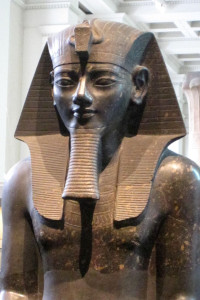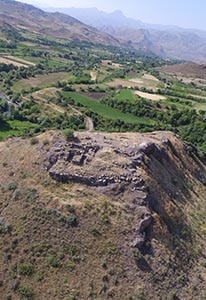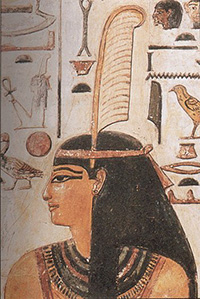
Not a Friend of ASOR yet? Sign up here to receive ANE Today in your inbox weekly!

September 2023
Vol. 11, No. 9
The Harsh Life of Diplomatic Messengers in Egypt in the Late Bronze Age
By Mohy-Eldin E. Abo-Eleaz
International relations in Egypt during the Late Bronze Age (~1500 BCE – 1200 BCE) depended mainly on diplomatic envoys; the large quantity of exchanged royal gifts and the increase of marriage alliances are evidence of these relations. Negotiations conducted through official messengers between the kings of Egypt and the kings of Near Eastern states were an important mechanism for managing these relationships.
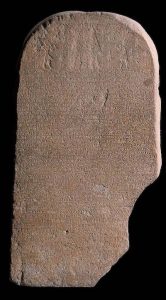
Stele of Thuthmose III (1479–1425 BCE) from Gebel Barkal (Sudan). Harvard University—Boston Museum of Fine Arts Expedition. Photograph © 2023 Museum of Fine Arts, Boston
The exchange of messengers was an expression of good relations between kings, who were keen to secure safe passage and the brisk exchange of messengers. In the Gebel Barkal stele in Nubia, Thutmose III boasts: “[I spread] my dread in the ends of Asia without my messenger being hindered.” These official messengers had to withstand numerous dangers and difficulties to accomplish their missions, such as the possibility of encountering bad roads, robberies, and assaults. But the risks didn’t end there: correspondence between the kings of Egypt and various rulers across the Near East suggests that royal messengers were subject to harsh treatment especially in the Egyptian court, raising questions as to whether the Egyptian king was violating diplomatic norms—the envoys’ “diplomatic immunity”, so to speak.
One example comes from correspondence exchanged between Egypt and Babylon, which is preserved in the form of clay tablets found at Tell el-Amarna. The Babylonian king, Kadashman-Enlil I, complained that the Egyptian king, Amenhotep III had unreasonably detained his messenger for 6 years (EA 3). He also allegedly disparaged Kadashman-Enlil’s messengers as “nobodies” and “liars”, apparently perturbed that they were asking to meet with the Babylonian princess whom Amenhotep had married as part of a negotiated alliance. It seems that Amenhotep was angered by what he saw as disrespect on the part of the Babylonian king, who had delegated envoys from the lower ranks of society. To humiliate the messengers, Amenhotep gathered all his wives—including the Babylonian princess—and presented them without indicating who was who. Since the messengers were of such a station that they did not know the Babylonian princess, they could not identify her; they did not dare ask which one she was.
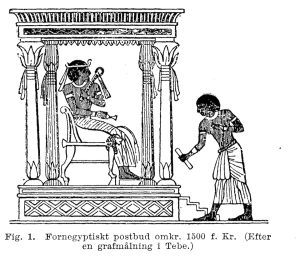
A Messenger appears before the king. Drawing after a mural in a Theban tomb. From Norisk familjebok (1915)
This was not an isolated incident. Later, the Babylonian king Burnaburiyaš II wrote to Akhenaten likewise to complain about the detention of his messenger for two years in Egypt. And a similar case occurred during the reign of Ramesses II, who had married two Babylonian princesses just as Amenhotep III did a century earlier. He also did not permit the messengers of her father to visit her in Egypt. All of these letters reflect the tension between the two powers, highlighting the Babylonian envoys’ negative experience at the royal court in Egypt during the reigns of Amenhotep III to Ramesses II.
Accusations of mistreatment were not limited to correspondence between the Egyptian and Babylonian king. According to the Assyrian king Ashur-uballit I, the Egyptian king Akhenaten went so far as to endanger the Assyrian messengers’ lives: “Why should messengers be made to stay constantly out in the sun and so die in the sun?” (EA 16) It is possible that the messengers were forced to stand in the blazing sun for hours as part of Akhenaten’s new religious rituals surrounding the worship of the sun disk Aten. Or, Akhenaten may have been reacting to the delay of his own messengers in Assyria. The latter is suggested by another message from the Assyrian king, explaining that he had detained the Egyptian messengers due to bandits.
A further example is found in the correspondence from Tušratta, the Mitanni king, who sent his chief minister, Keliya, along with another envoy to the court of Amenhotep III, requesting they not be delayed. However, they were detained in Egypt for so long that Tušratta wrote again, complaining that they had become forgotten. Their detention might have been for a criminal reason related to their reputations and the involvement of other messengers of Mitanni in an unknown crime that occurred during an earlier visit to Egypt. In any case, Akhenaten allowed them to return home after taking further punitive actions against them.
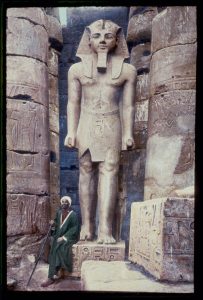
Statue of Rameses II in the Temple of Luxor. G. Eric and Edith Matson Photograph Collection, Library of Congress.
The detention of envoys as retaliation is clear from another letter, also from the period of Akhenaten concerning the envoys of the King of Alashiya (Cyprus). Here, it is suggested that Akhenaten detained the messengers because he thought that his own messenger was being held in Alashiya. However, the king of Alashiya made the excuse that it was a plague on the island that caused the three-year delay in returning the messenger to Egypt. Whether or not Akhenaten was persuaded is unknown.
During the Nineteenth Dynasty, Ḫattušili III, the king of Hittites, wrote to Ramesses II asking about the treatment of Zuwa, the Hittite messenger to Egypt. Ramesses left Ḫattušili in no doubt about what he thought of his envoy, responding, “Who is this dog?” and stating that he had ordered Zuwa to be bound by hand and foot. Hattušili objected, stating “to chain the hands and feet of messengers is not according to custom,” and “It is not right to kill a messenger!” suggesting that there were some commonly accepted standards, even if Ramesses ignored them.
The rulers in Syria-Palestine complained repeatedly of neglect and detention of their messengers inside Egypt. Sometimes, the complaint merely concerns the neglect of responding to their messages. In other cases, it was because of the Egyptian king’s favoritism towards messengers from one city over others, such as when the messenger of Akka was honored more than Byblos’ messengers. In an extraordinary example, the citizens of Tunip themselves wrote to Akhenaten about the neglect and detention of their messengers for twenty years in Egypt.
From the letters above, we must question whether the accusations are true, and whether the Egyptian kings violate “diplomatic immunity” of the messengers. Is it possible the foreign rulers exaggerated for rhetorical effect, perhaps using routine phrases in the letters without real meaning? We can make the following observations:
- 1- In some cases, it was the kings’ ignorance of the distances between Egypt and the neighboring countries that could foster a repeated request for sending back envoys.
- 2- The time taken by the messengers to travel from one court to another obviously depended on a number of factors. These could include dissimilar terrains, different purposes of travel, and variations of seasons. One factor that should be considered when calculating traveling speed to Egypt is the combination of transport being used.
- 3- It was common for the envoys and foreign messengers to reside in the king’s court for indefinite periods, and the return of any envoy to his own country depended on the consent of the host king.
- 4- Neither the envoys themselves nor the kings who sent them were much in control over the length of their stay in a foreign kingdom, especially if their host was not particularly cooperative or diligent in expediting their return.
- 5- Delays might have been due to the time taken to draw up a response for the delegation to take back to their kings, to put together a consignment of gifts to accompany them, or to do all the necessary preparations for the dispatch of a royal bride.
- 6- No specific dates occur in the letters, whether from the Egyptian palace or to the palaces of the other Near Eastern kings; sometimes it was years that were a symbolic number to express a long period of time.
If all the previous considerations are taken into account, one can largely acknowledge the credibility of the letter-writers’ complaints about long detentions. Neglect could occur as an initial stage that might lead to detention, and possibly even death, inside the Egyptian palace for political, bureaucratic, and criminal reasons.
Even so, the messengers cannot be regarded as having diplomatic immunity in the modern sense, despite the protests of the aggrieved kings. But from the correspondence, it appears that Egypt was still the country most known for detaining foreign messengers during the Late Bronze Age, and therefore the most dangerous diplomatic posting.
Mohy-Eldin E. Abo-Eleaz is Associate Professor History and Civilization of Egypt and the Ancient Near East at Minia University.
Further Reading
Abo-Eleaz, M.-E. E. (2018). Neglect and Detention of Messengers in Egypt during the Fourteenth and Thirteenth Centuries BCE. Journal of the American Research Center in Egypt, 54:17–34.
Bryce, T. (2004). Letters of the Great Kings of the Ancient Near East: The Royal Correspondence of the Late Bronze Age. Routledge.
Gestoso Singer, G. (2016). Fortunes and Misfortunes of Messengers and Merchants in the Amarna Letters. Fortune and Misfortune in the Ancient Near East: Proceedings of the 60th Rencontre Assyriologique Internationale Warsaw, 21–25 July 2014, 143-161.
Moran, W.L. 1992. The Amarna Letters. Johns Hopkins University Press.
Rainey, A.F. 2015. The El-Amarna Correspondence: A New Edition of the Cuneiform Letters from the Site of El- Amarna Based on Collations of All Extant Tablets. In W. Schniedewind and Z. Cochavi-Rainey, (eds.), Handbook of Oriental Studies. Vols.1-2. Leiden, Brill.
Want To Learn More?
How Did the Kings of the Late Bronze Age Deal with Rumors?
By Mohy-Eldin Elnady Abo-Eleaz
The Late Bronze Age royal courts relied on envoys and messengers to convey information between the Great Powers. So how did they deal with rumors, misinformation and other forms of fake news? Read More
Fire Beacons and Message Relays: Staying in Touch in the Ancient Near East
By Tiffany Earley-Spadoni
In the ancient world, people were able to communicate messages at the speed of light. That light was provided by fire signals, part of sophisticated communications networks created by states and empires. Read More
Peace in Ancient Egypt
By Vanessa Davies
Peace is a common aspiration. But what does the Egyptian version of a peace treaty with the Hittites tell us about their conception of peace? What did they really mean by “peace”? Read More
